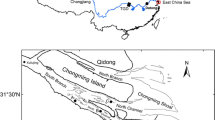Abstract
The monitoring, field, and satellite datasets are used to estimate changes in suspended sediment budget for the Selenga and Upper Angara river deltas. Sediment deficit during recent decades dominates delta evolution due to decrease in the sediment delivery to the delta since the middle of the 1970s by 51% for the Selenga River and by 70% for the Upper Angara River. The observed decline in the sediment runoff and peak water flows associated with the sediment deposition within the inundated flood-plain of the deltas leads to the reduction of the sediment aggradation rates over both deltas. Under low water flows we observed longitudinal increase of the sediment transport rates along Selenga River delta; the Upper Angara constantly reduces sediment transport rates under various hydrological conditions.
Similar content being viewed by others
References
N. I. Alekseevskii, Formation and Movement of River Sediments. (MGU, Moscow, 1998) [in Russian].
M. A. Glazovskaya, “Geochemical Barriers in Plain Solis, Their Typology, Functional Features, and Environmental Value,” Vestnik Moskovskogo Universiteta, Ser. 5, Geografiya, No. 1 (2012) [in Russian].
A. P. Lisitsyn, “The Marginal Filter of the Ocean,” Okeanologiya, No. 5, 34 (1994) [Oceanology, No. 5, 34 (1994)].
T. G. Potemkina, “Hydrological-morphological Zoning of the Mouth Zone of the Selenga River,” Vodnye Resursy, No. 1, 31 (2004) [Water Resour., No. 1, 31 (2004)].
M. K. Tarasov and O. V. Tutubalina, “A Method for Determination of Water Turbidity in the Selenga River and in the Adjoining Area of Lake Baikal Using Remote Sensing Data,” Issledovanie Zemli iz Kosmosa, No. 1 (2018) [in Russian].
Erosion-channel Systems, Ed. by R. S. Chalov, A. Yu. Sidorchuk, and V. N. Golosov (INFRA-M, Moscow, 2017) [in Russian].
N. I. Alexeevsky, R. S. Chalov, K. M. Berkovich, and S. R. Chalov, “Channel Changes in Largest Russian Rivers: Natural and Anthropogenic Effects,” Int. J. River Basin Management, No. 2, 11 (2013).
S. R. Chalov, V. O. Bazilova, and M. K. Tarasov, “Suspended Sediment Balance in Selenga Delta at the Late XX-Early XXI Century: Simulation by LANDSAT Satellite Images,” Water Resour., No. 3, 44 (2017).
S. R. Chalov, J. Jarsjo, N. S. Kasimov, A. O. Romanchenko, J. Pietron, J. Thorslund, and E. V. Promakhova, “Spatio-temporal Variation of Sediment Transport in the Selenga River Basin, Mongolia and Russia,” Environ. Earth Sci., No. 2, 73 (2014).
S. Chalov, J. Thorslund, N. Kasimov, D. Aybulatov, E. Ilyicheva, D. Karthe, A. Kositsky, M. Lychagin, J. Nittrouer, M. Pavlov, J. Pietron, G. Shinkareva, M. Tarasov, E. Garmaev, Y. Akhtman, and J. Jarsjo, “The Selenga River Delta: A Geochemical Barrier Protecting Lake Baikal Waters,” Regional Environ. Change, No. 7, 17 (2017).
G. Chander, B. L. Markham, and D. L. Helder, “Summary of Current Radiometric Calibration Coefficients for Landsat MSS, TM, ETM+, and EO-1 ALI Sensors,” Remote Sens. Environ., No. 5, 113 (2009).
T. Y. Dong, J. A. Nittrouer, M. J. Czapiga, H. Ma, B. McElroy, E. Il’icheva, M. Pavlov, S. Chalov, and G. Parker, “Roles of Bank Material in Setting Bankfull Hydraulic Geometry as Informed by the Selenga River Delta, Russia,” Water Resour. Res., 54 (2019).
N. L. Frolova, P. A. Belyakova, V. Yu. Grigoriev, A. A. Sazonov, L. V. Zotov, and J. Jarsjo, “Runoff Fluctuations in the Selenga River Basin,” Regional Environ., Change, 17 (2017).
A. N. Gelfan and T. D. Millionschikova, “Validation of a Hydrological Model Intended for Impact Study: Problem Statement and Solution Example for Selenga River Basin,” Water Resour., No. 1, 45 (2018).
E. Park and E. M. Latrubesse, “Modeling Suspended Sediment Distribution Patterns of the Amazon River Using MODIS Data,” Remote Sens. Environ., 147 (2014).
T. M. Pavelsky and L. C. Smith, “Remote Sensing of Suspended Sediment Concentration, Flow Veiocity, and Lake Recharge in the Peace-Athabasca Delta, Canada,” Water Resour. Res., 45 (2009).
J. Pietron, J. Nittrouer, S. Chalov, T. Dong, N. Kasimov, G. Shinkareva, and J. Jarsjo, “Sedimentation Patterns in the Selenga River Delta under Changing Hydroclimatic Conditions,” Hydrol. Processes, No. 2, 32 (2018).
T. G. Potemkina, “Sediment Runoff Formation Trends of Major Tributaries of Lake Baikal in the 20th Century and at the Beginning of the 21st Century,” Russ. Meteorol. Hydrol., No. 12, 36 (2011).
T. G. Potemkina and V. L. Potemkin, “Sediment Load of the Main Rivers of lake Baikal in a Changing Environment (East Siberia, Russia),” Quat. Int., 380-381 (2015).
K. G. Ruddick, V. de Cauwer, Y. Park, and G. Moore, “Seaborne Measurements of Near Infrared Water-leaving Reflectance: The Similarity Spectrum for Turbid Waters,” Limnol. Oceanogr., No. 2, 51 (2006).
A. Tejedor, A. Longjas, I. Zaliapin, and E. Foufoula-Georgiou, “Delta Channel Networks: 1. A Graph-theoretic Approach for Studying Connectivity and Steady State Transport on Deltaic Surfaces,” Water Resour. Res., No. 6, 51 (2015).
Author information
Authors and Affiliations
Corresponding author
Additional information
Russian Text © The Author(s), 2019, published in Meteorologiya i Gidrologiya, 2019, No. 10, pp. 50–59.
Funding
The research was supported by the Russian Foundation for Basic Research (grant 17-29-05027). The analysis of morphodynamic parameters of the channel was supported by the Russian Science Foundation (grant 18-17-00086). The data generalization was performed in the framework of research works of the Land Hydrology Division of MSU Geography Department. The field studies were partly supported by the grant of the Russian Geographical Society “The Baikal Expedition.”
About this article
Cite this article
Chalov, S.R., Potemkina, T.G., Pashkina, M.P. et al. Evolution of Suspended Sediment Budget in the Deltas of Lake Baikal Tributaries. Russ. Meteorol. Hydrol. 44, 667–673 (2019). https://doi.org/10.3103/S1068373919100042
Received:
Revised:
Accepted:
Published:
Issue Date:
DOI: https://doi.org/10.3103/S1068373919100042




